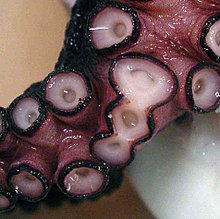This article has multiple issues. Please help improve it or discuss these issues on the talk page. (Learn how and when to remove these messages)
|


A deformity, dysmorphism, or dysmorphic feature is a major abnormality of an organism that makes a part of the body appear or function differently than how it is supposed to.
Causes
Deformity can be caused by a variety of factors:
- Arthritis and other rheumatoid disorders
- Chronic application of external forces, e.g. artificial cranial deformation
- Chronic paresis, paralysis or muscle imbalance, especially in children, e.g. due to poliomyelitis or cerebral palsy
- Complications at birth
- Damage to the fetus or uterus
- Fractured bones left to heal without being properly set (malunion)
- Genetic mutation
- Growth or hormone disorders
- Skin disorders
- Reconstructive surgery following a severe injury, e.g. burn injury
Deformity can occur in all organisms:
- Frogs can be mutated due to Ribeiroia (Trematoda) infection.
- Plants can undergo irreversible cell deformation
- Insects, such as honeybees, can be affected by deformed wing virus
- Fish can be found with scoliosis due to environmental factors
Mortality

In many cases where a major deformity is present at birth, it is the result of an underlying condition severe enough that the baby does not survive very long. The mortality of severely deformed births may be due to a range of complications including missing or non-functioning vital organs, structural defects that prevent necessary function, high susceptibility to injuries, abnormal facial appearance, or infections that eventually lead to death.
In some cases, such as that of twins, one fetus is brought to term healthy, while the other faces major, even life-threatening defects. An example of this is seen in cattle, referred to as amorphous globosus.
In mythology
There are many instances of mythological characters showing signs of a deformity.
- Descriptions of mermaids may be related to the symptoms of sirenomelia.
- The Irish mythology includes the Fomorians, who are almost without exception described as being deformed, possessing only one of what most have two (eyes, arms, legs, etc.) or having larger than normal limbs.
- Hephaestus, of Greek Mythology, was born with a club foot.
See also
- Birth defect
- Body dysmorphic disorder
- Congenital abnormality
- Disfigurement
- Genetic variation
- Malformation
- Monstrous birth
- Phocomelia
- Polymelia
- Teratology
References
- Lockhart JA (November 1967). "Physical nature of irreversible deformation of plant cells". Plant Physiology. 42 (11): 1545–1552. doi:10.1104/pp.42.11.1545. PMC 1086764. PMID 16656691.
- "Body Deformities". Regional Aquatics Monitoring Program (RAMP). Alberta Environment and Parks Environmental Monitoring and Science Division. Retrieved 2022-03-19.
- Boulgakow B (1926). ""Arrest of Development of an Embryo. A Case of Acephalus Holoacardiacus showing Arrest of Development of all Tissues in Embryonic Period."". Journal of Anatomy. 61 (Pt 1): 68–93. PMC 1249928. PMID 17104128.
- Bazopoulou-Kyrkanidou E (1997-10-17). "What makes Hephaestus lame?". American Journal of Medical Genetics. 72 (2): 144–155. doi:10.1002/(SICI)1096-8628(19971017)72:2<144::AID-AJMG5>3.0.CO;2-V. PMID 9382134.
Further reading
- Hogan CM (2010). "Mutation". In Monosson E, Cleveland CJ (eds.). Encyclopedia of Earth. Washington DC: National Council for Science and the Environment. Archived from the original on 2011-04-30.